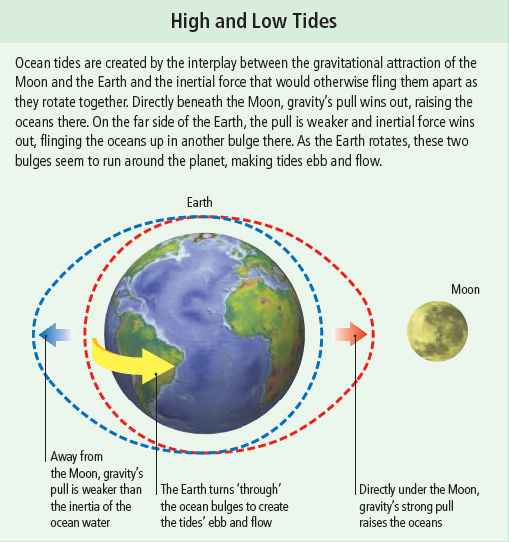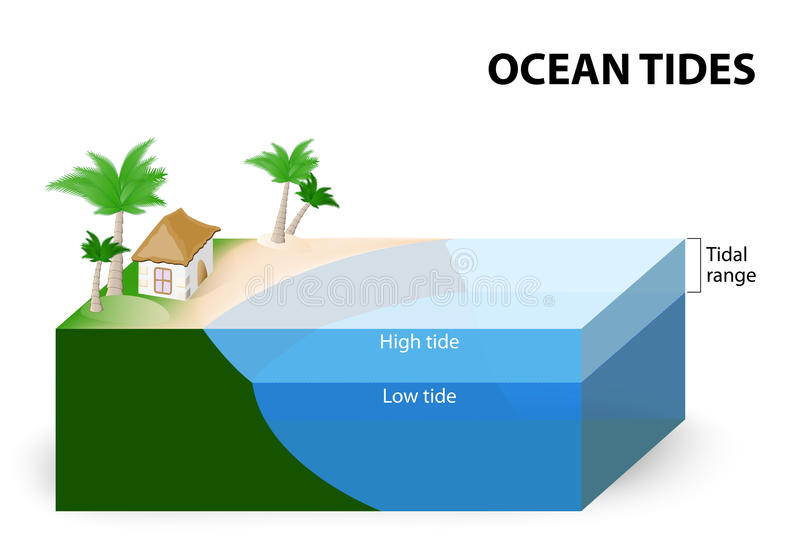Twice a day, the sea rises up the shore then falls back again
in tides. However, the effect is only local. While the tide
is rising in one place, it is falling in another, as huge forces are
exerted on the vast mass of water in the oceans.
Tides fall in one place and rise in another because the water in
the oceans is moving around, flowing this way and that across the
face of the planet, so that it piles up in one place, making the tide
flow in, and drops away in another, making the tide ebb. It is this
continual ebb and flow of ocean water that makes many simple
explanations of why tides occur misleading or wrong.
The Moon and the Sun
Tides do not occur simply because the oceans are lifted up by the
Moon’s gravity as they pass beneath it. The mutual gravitational
attraction between the Moon and the Earth is indeed at the heart
of it, but the Moon does not just pull the waters up. As the Moon
and the Earth circle around their mutual gravitational centre, the
attraction between all parts of them distorts both, stretching them
out into slight ovals. Of course, the solid Earth and the Moon
are too rigid to be distorted by more than a couple of inches. But
because water can flow freely, the effect on the Earth’s oceans is
more dramatic. As the solid Earth is pulled towards the Moon
through its oceans, like a ship tugged through the sea, the ocean
waters flow around its surface to create a bulge of water several
feet high on either side of the world.
But while the Earth spins, the oceans flow so that the bulges stay
in line with the Moon, which stays in pretty much the same place.
Of course, on Earth it seems as if it is the bulges that move, not
the Earth, and the effect is that the bulges run around the world,
making the tide rise and fall twice a day as they pass. Actually, the
Moon moves slightly farther around the Earth every day, so tides
occur not every 12 hours, but every 12 hours 25 minutes. And
because the Earth is also tilted, the Moon is alternately overhead
north and south of the equator, so one tide each day is slightly
higher than the other as well.
An additional factor is the Sun. The Sun may be far away but
it is so massive that it also affects the tides. When the Moon and
Sun line up every fortnight at the Full Moon and New Moon,
their pulling power combines to create extreme high and low
tides that are called Spring Tides. When they are at right angles
to each other, at the Half Moon, they counteract each other,
creating shallow Neap Tides.
Tidal sloshing
If the Earth was completely smooth and turned only slowly,
everywhere would experience this neat twice-daily, twicemonthly
rhythm of tides. But the world is neither smooth, nor
does it turn slowly. Tidal forces are far too weak to overcome
friction with the ocean bed sufficiently to prevent the tidal wave
getting very slightly ‘left behind’ the Moon. Moreover, they do not
sweep unhindered around the Earth. Their path is continually
blocked by continents, and they are given a particular twist by the
spinning of the Earth beneath.
The effect is that the tidal waves slosh counterclockwise around
and around the ocean basins, rising and falling with a rhythm that
does not quite tie in with the passage of the Moon. As a result,
high tides do not necessarily occur when the Moon is overhead,
but when a combination of these sloshing oscillations and tidal
forces piles water to its greatest height.
Each ocean basin is a very different shape and so has its own
tidal flow. In the South Atlantic, for instance, tides slosh from
south to north, taking 12 hours or so to sweep from the tip of
Africa to the equator. In the North Atlantic, they sweep around
counterclockwise. In the Gulf of Mexico, there is just one tide
a day, not two.
Standing waves
The picture is further complicated by the effect of coastlines and
shallows. In the open ocean, tides tend to raise the water only
1 m (3 ft) or so. But shallows and inlets funnel the waters, setting
all kinds of other rhythms in motion. Enclosed seas such as the
Mediterranean have their own unique tidal cycle, often created as
standing waves called ‘seiches’ sweep back and forth like a ripple
in a bathtub. These waves can cancel out tides altogether if the
sea’s natural period of oscillation is very different from that of
the open ocean tides. But if they match, a resonance may be set up
– like wind through an organ pipe – that piles up very high tides,
like those of the Bay of Fundy in Nova Scotia, which can
rise and fall more than 15 m (50 ft).
This extraordinary complexity has meant that, in the past, the
only way to predict tides was to collect data over enough years
to extrapolate forwards into the future. Nowadays, however,
oceanographers use computer models that take into account
detailed shapes of the ocean floor and coastline. These are being
combined with increasingly accurate measurements of the height
of the ocean surface – called ocean altimetry – and of the ocean
bed made possible by satellite technology.

we seen The Four Different Types of Tides on the earth
Diurnal Tide. ••• A diurnal tide has one episode of high water and one episode of low water each day. …
Semi-diurnal Tide. ••• A semi-diurnal tide has two episodes of equal high water and two episodes of low equal water each day. …
Mixed Tide. ••• …
Meteorological Tide.
Some bodies of water (the Mediterranean, Baltic, Black Sea, Caspian Sea, and Caribbean) don’t respond strongly to tidal forces. The reasons for this are a bit complex but basically it is due to their size and geographic nature. These areas are described as Non-Tidal.
Tides occur mainly in oceans because that is basically one huge body of water that is free to move all over the earth. Lakes and rivers do not cover enough area to have their water be moved significantly by gravity, or in other words, to have tides.

